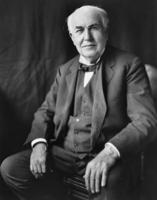| www.tmatlantic.com
Test & Soldering Equipment On-line Store |
|
D.E.V.I.C.E. (Wiki)Calculators Services |
|||||
Filter by first letter
|
Edison, Thomas
Thomas Alva Edison was born on February 11, 1847. He was an American inventor and businessman who developed lots of devices in electric power generation, mass communication, sound recording, and motion pictures. His inventions like phonograph, the motion picture camera and early versions of the electric light bulb have had a widespread impact on the modern industrialized world. Thomas Edison was one of the first inventors to apply the principles of organized science and teamwork to the process of invention, working with many researchers and employees. The first industrial research laboratory was established by him as well in 1876. It was built in Menlo Park, in Middlesex County, New Jersey, with the funds from the sale of Edison's quadruplex telegraph. The quadruplex telegraph was Edison's first big financial success, and Menlo Park became the first institution set up with the specific purpose of producing constant technological innovation and improvement. Nearly all of Edison's patents were utility patents, which were protected for 17 years and included inventions or processes that are electrical, mechanical, or chemical in nature. Edison's name is registered on 1,093 patents. In 1878, Edison formed the Edison Electric Light Company in New York City. Edison was granted a patent for a motion picture camera, labeled the "Kinetograph". In 1891, Thomas Edison built a Kinetoscope or peep-hole viewer. This device was installed in penny arcades, where people could watch short, simple films. In the late 1890s Edison worked on developing a lighter, more efficient rechargeable battery (at that time called an "accumulator"). He looked on them as something customers could use to power their phonographs but saw other uses for an improved battery, including electric automobiles. He had his lab work on many types of materials, eventually settling on a nickel-iron combination. Edison obtained a US and European patent for his nickel–iron battery in 1901 and founded the Edison Storage Battery Company. Thomas Edison died on October 18, 1931, in his home, "Glenmont" in Llewellyn Park in West Orange, New Jersey. Citing: Wikipedia.org More interesting facts:
Demonstration of the first incandescent light bulb |
Measurement History Events
|
Site mapPrivacy policyTerms of Use & Store PoliciesHow to BuyShippingPayment




|

























